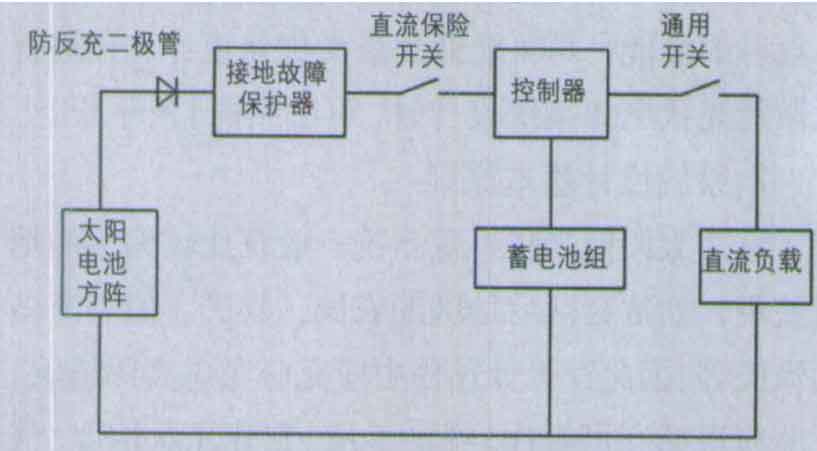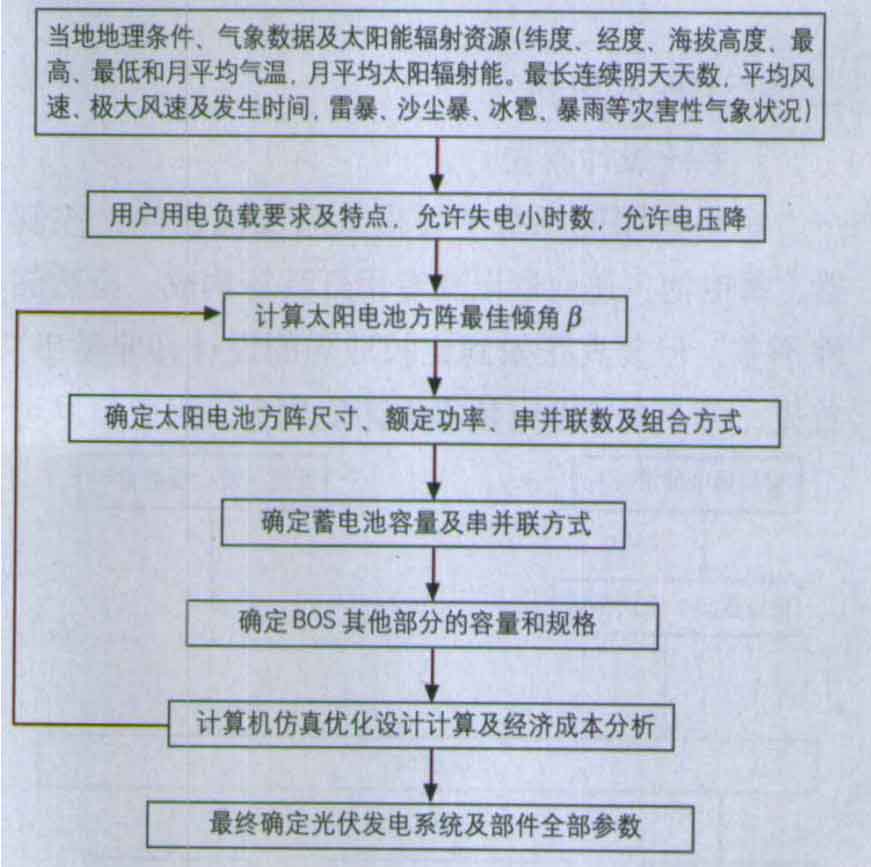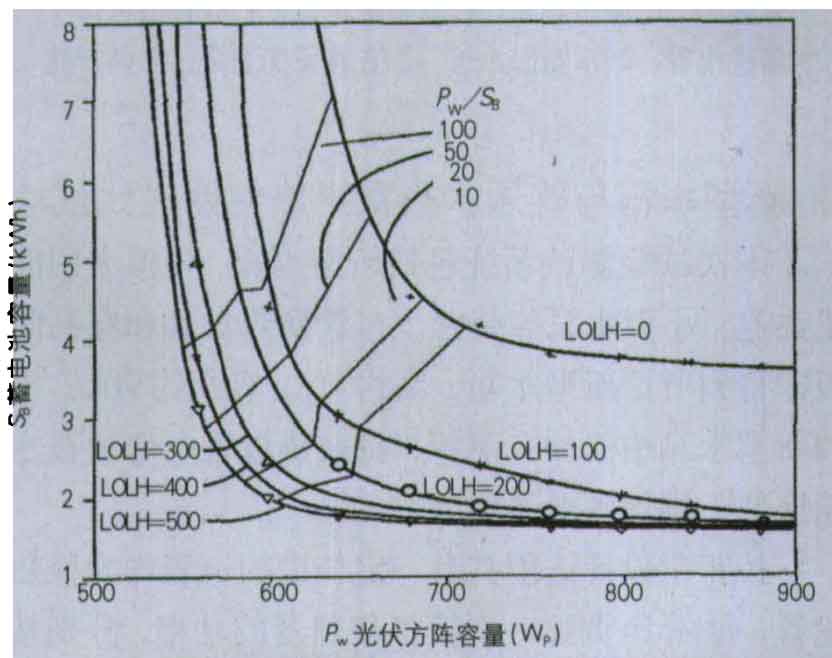Solar Home System is one of the earliest applications of solar cells on the ground. In the early 1980s, China actively researched and promoted this technology. As of 2006, nearly one million household solar photovoltaic power generation systems have been applied in residential households (mainly in impoverished mountainous areas and pastoral areas). With the market-oriented and commercialized development of solar photovoltaic technology application, expanding the application of household solar photovoltaic power systems and optimizing the combination of power systems is an important technical means.
1. Basic design ideas
1.1 System involved processes
Household solar photovoltaic systems are mainly composed of solar cell modules, controllers, batteries, inverters, and specialized lighting fixtures. Although there are not many components, achieving an ideal design is not an easy task. Firstly, solar photovoltaic power generation relies on solar radiation, so it is necessary to grasp the local meteorological and environmental conditions as much as possible. Secondly, the electricity demand of users should also be considered, and based on these two factors, Comprehensively consider and calculate the ten parameters of the system to maximize the performance of each component and achieve maximum optimization design. When designing a solar photovoltaic power supply system, reference can be made to the design shown in Figure 1

1.2 System Design Principles
Household solar photovoltaic power systems are generally used in relatively remote areas, such as farmers and herdsmen in poor and underdeveloped areas, and fishermen on remote islands. Therefore, in the design process, the actual situation should be fully considered. Generally, principles such as high reliability, economic applicability, and full attention to the impact of geography and climate environment should be followed.
2. Electricity demand analysis
The electricity demand mainly includes the size of the electricity load, load characteristics, duration of use, and power supply guarantee rate. Household solar photovoltaic power systems are mainly applied in impoverished and remote areas. Due to the high cost of photovoltaic power generation, the most urgent requirement for low-income groups is lighting, with low requirements for power supply time and guarantee rate. With the improvement of economic capacity, users have a certain increase in their requirements for electricity consumption time and power supply guarantee rate, mainly by listening to radio and watching TV programs. For some affluent families, there will be electricity requirements for small production equipment, based on high income. Due to long-term use of electrical appliances, these users need a higher power supply guarantee rate.
Before designing a solar photovoltaic power generation system and selecting system equipment, it is necessary to fully understand the characteristics of the load. The most important characteristics of load mainly include whether it is DC load or AC load, whether it is impulse load or non impulse load, and whether it is important load or general load. Different types of loads have different characteristics:
(1) Resistive load: such as incandescent bulbs, electronic energy-saving lamps, point heaters, etc., with the same current and voltage, and no surge current.
(2) Inductive loads: such as generators, refrigerators, and water, where the voltage is ahead of the current and has an impact. The surge current of the electric motor is 5-8 times the rated current, and the time is 50-150ms. The surge current of the refrigerator is 5-10 times the rated current, and the time is 100-200ms.
(3) Power electronic loads such as light bulbs (with electronic ballasts), televisions, computers, etc. have impact electricity.
3. Selection of power supply type
Based on the above electricity demand analysis, considering the direct generation of direct current from solar photovoltaic power generation, DC power supply systems and AC power supply systems can be designed separately to meet the needs of different user groups.
(1) DC system: The DC system consists of solar panels, electricity, and controllers, which can provide DC power for specialized lighting fixtures, radios, televisions, etc., as shown in Figure 2.

(2) AC load system: In addition to using solar cell components, batteries, and controllers in the DC system, an inverter has been added to convert DC power into AC power in the AC load system, as shown in Figure 3.

The independent solar photovoltaic power generation system consists of a solar cell array, anti reverse charging diodes, controllers, inverters, battery packs and brackets, and transmission and distribution equipment. In foreign literature, a solar cell array is often referred to as a solar generator, while the rest is collectively referred to as the “Balance of System” (BOS) of the solar generator. Sometimes, BOS also includes the land occupied by the solar cell array and the lightning safety system. When the solar cells are very expensive, BOS accounts for a relatively small proportion of the cost in the entire independent solar photovoltaic power generation system, But with the continuous price reduction of solar cells, the proportion of BOS expenses gradually increases.
4. Capacity design
For the design of solar photovoltaic power generation systems, the first step is to calculate and determine the capacity of the system. The DC system mainly has two capacity parameters: solar cell components and batteries, while the AC system also needs to consider the interrelated, interdependent, and independent parameters of the inverter. The solar cell components determine the possible power generation of the system, and the capacity of the inverter is determined based on the type of load and total power, The customer volume of batteries is determined by the daily charging and discharging capacity, the number of self-sufficiency days to be guaranteed, and the maximum allowable discharge depth.

In the design process, it is first required to have a detailed understanding of the local solar radiation resources and geographical meteorological data. Generally, it is required to master the daily average solar radiation, monthly average solar radiation, and continuous rainy days. Based on the mathematical models of each component, computer simulation is used to fit the hourly power generation, battery charging, and load working conditions of the solar cell, And predict the required capacity of solar cell arrays and battery packs under different power supply reliability requirements. The capacity design program diagram of an independent solar photovoltaic power generation system is shown in Figure 4.
5. Application of design software in household solar photovoltaic power supply systems
5.1 Software Design Description
When designing household solar photovoltaic systems, it is more convenient to use professional solar photovoltaic design software to optimize the design. If used properly, it can greatly reduce computational complexity, save time, and improve efficiency and accuracy. For example, the solar radiation in the obtained meteorological data is generally the horizontal data recorded by meteorological stations. This kind of conversion is generally computationally complex, and with the help of software, only the azimuth or inclination angle needs to be inputted to immediately see the structure of the changing system.
At present, there are about a dozen commonly used system design software internationally, such as PV * SOL developed by Dr. Gehard Valentin of Shell Solar Photovoltaics and RETSCREEN of Canada, mainly concentrated in countries with developed solar photovoltaic industries such as the United States, Germany, and Japan, and rarely developed in other countries.
When conducting actual design, the first step is to choose the installation location of the solar photovoltaic system. If there is no exact location data in the database, data from nearby locations can be selected or relevant data can be obtained through other means and input into the software. Then choose the type of system: DC system, AC system, hybrid system, each with a different design method. The next step is the selection and input of loads. Detailed information such as the type of load, the total working time of the year, the amount of electricity consumed, and the number of undetermined working hours per day are inputted into the software. The software selects the models of components, batteries, and other “BOS” devices, and after simulation, a detailed simulation report will be displayed, The content parameters include: the number of components and batteries, the number of series and parallel PV components, the annual power generation of the PV components, the annual power consumption of the load, the solar radiation of the PV array, the efficiency of the PV components, the possibility of system efficiency loss, battery status, optimal array tilt angle, and so on. In addition, economic and environmental benefits analysis of solar photovoltaic systems can also be conducted. The analysis of economic benefits involves the initial investment cost of purchasing devices and installation, the cost of annual maintenance and fuel replacement, and the occasional cost of instrument replacement and repair. Environmental analysis mainly includes parameters such as cumulative saved standard coal, cumulative reduction of CO emissions, cumulative reduction of SO emissions, etc.
5.2 Optimization combination of solar cell module capacity and battery capacity
In household solar photovoltaic power systems, the power generation of solar cell modules and the capacity of batteries should be maximized to match the power consumption of the load. By using PV software and inputting local meteorological data, the current and voltage parameters of solar photovoltaic modules on the optimal inclined plane can be calculated. At the same time, the load electricity load curve, solar photovoltaic module capacity, and battery capacity can be inputted, without considering the loss of transmission and distribution points. Therefore, computer simulation results can be simulated to show that the capacity of solar photovoltaic modules and batteries varies with the number of hours of power loss under each year’s load.

Figure 5 shows the matching relationship between battery capacity S and solar photovoltaic module capacity Pw, using battery S (kWh) as the vertical axis and solar photovoltaic module capacity Pw (W;) as the horizontal axis, with 6 selected power outage hours of 0100200, 300, 400, and 500 hours, respectively.
6. Summary
The household solar photovoltaic power supply system is constantly improving and developing, and as a commercial, industrialized, and standardized small-scale power supply product, this system is an inevitable trend in the market development.
